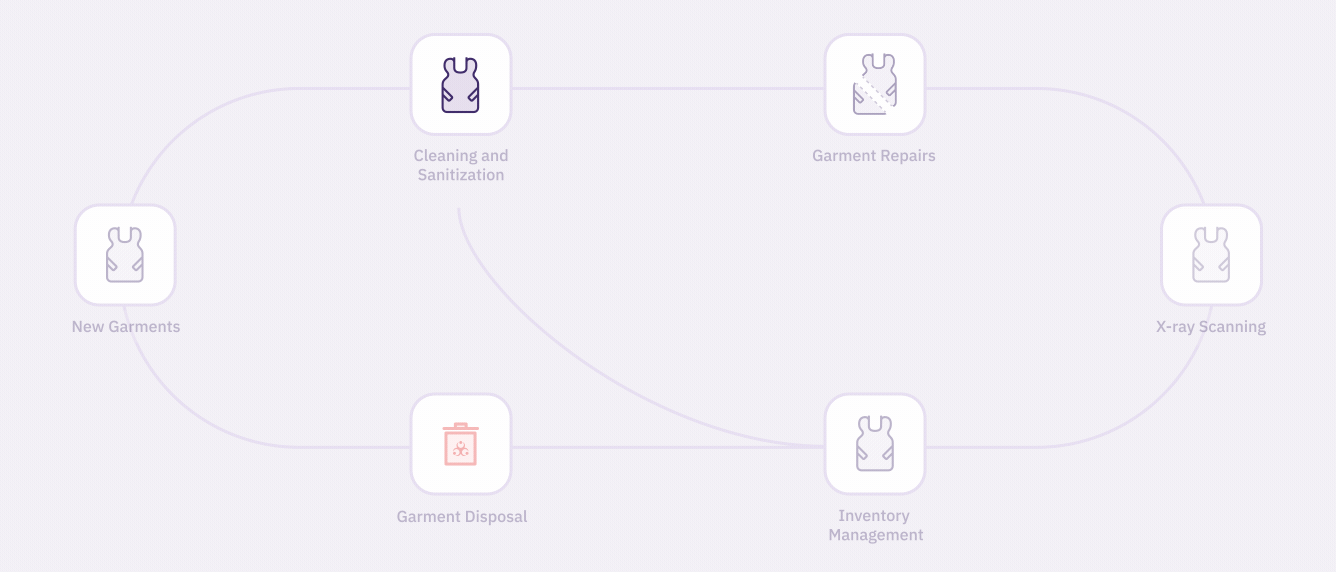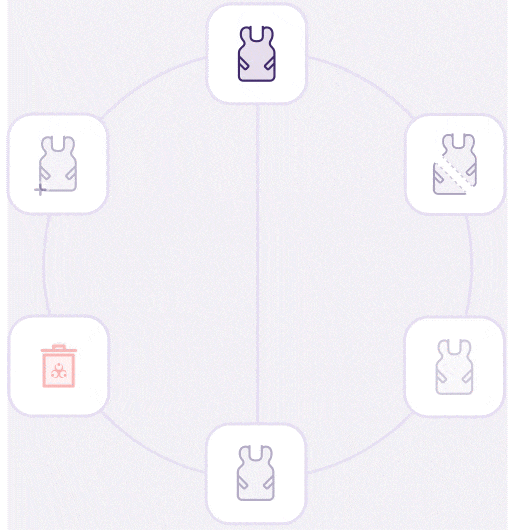Radiological Care Services
X-ray Garments Should Protect, Not Infect®
We clean, sanitize, repair, inventory, and X-ray scan your lead aprons
1+ Million
X-ray garments serviced
43 States
served by RCS
500+ Teams
use RCS services
10+ Years
as X-ray garment care experts
We Simplify Lead Garment Management
The process for maintaining the cleanliness and integrity of X-ray garments is broken, often falling on busy staff and taking time away from patient care. RCS is the world’s first company to provide a comprehensive X-ray garment service platform for hospitals.
Why RCS is the Trusted Provider
Both RCS founders acquired ringworm in two different health networks from wearing hospital-owned vendor garments. They discovered lead garments were overlooked when it came to cleaning procedures.
As a result, we developed a proprietary cleaning & sanitization system for X-ray garments following best practice standards set by:
AORN
The Joint Commission
CDC
Over a decade later, we’ve now evolved into a full-service platform handling all of the day-to-day service needs for the X-ray garment inventories of healthcare networks and hospitals.
84% of Lead Garments Test Positive for Staph a and Ringworm
Dr. Jaber from Wayne State cultured 25 lead aprons and found that 21 (84%) were colonized with Tinea species (Ringworm) and Staphylococcus aureus. Additionally, 3 (12%) were found to be colonized with MRSA.
Our Services
Our services were created following best practice standards set by regulatory bodies. Service contracts benefit all departments within a hospital — from a radiology tech spending hours scanning lead aprons for integrity checks to a perioperative nurse searching for the least stained, smelly apron on the community lead rack.
Our Process
We take pride in developing a proven process for ensuring staff and patients are wearing safe X-ray garments.
-
Our process goes beyond wipes. Following guidelines from regulatory bodies, our cleaning process is two steps.
First step: Garments are tested then cleaned using friction.
Second step: Garments are properly sanitized.
The method is proven effective as a bactericidal, viricidal, fungicidal, and sporicidal solution for X-ray garments.
It is also endorsed by garment manufacturing companies and yields best practice outcomes as defined by AORN, TJC, and CDC.
-
Our complimentary garment repair services include:
exchanging broken buckles
replacing worn Velcro
adding hanging straps to skirts
mending ripped straps
sewing up torn binding
Watching for signs of wear and tear and repairing garments consistently helps keep garments in good working condition reduces the number of garments needing replaced annually.
This directly helps to protect your budget, as recognized by many Value Analysis Committees from healthcare networks across the nation.
-
We save your rad techs and staff members unnecessary radiation exposure and time by completing annual X-ray inspections.
You will receive a master report with details and images of each garment.
Radiographic examination of X-ray garments reveals cracks and tears that often go undetected during a visual or tactile examination.
Though it may not be mandated to perform an annual X-ray scan on your garments, we include it in our services because we absolutely feel it is a best practice to ensure staff and patient safety. (We have alarming year-over-year images to prove why!)
-
We update customer’s inventory information in RADCOMPLY™ after each service for all compliance needs.
Individual department reports and entire inventory exports are available in case of an audit or review. All service records, X-ray images, etc. are auto-archived in RADCOMPLY™ year-over-year.
Visit our blog to learn more about how to manage your lead apron inventory.
-
Our EPA-approved disposal program provides a quick, easy, and responsible option for you to retire your garments. Our team makes the process simple for you.
X-ray garments have historically contained heavy metals, including lead. Lead is in the Toxic Substances List under the Environment Protection Act Registry and it should not be disposed of as conventional garbage, but rather as hazardous waste.
When disposed of improperly, such materials pose contamination concerns for the environment.
-
RCS is a master distributor for top manufacturers.
When you choose to purchase new X-ray garments through RCS, we automatically asset tag and inventory them, perform annual X-ray scans to verify the integrity of the garment, and load the data into our cloud-based portal (RADCOMPLY™) for your records.
Wipes Aren’t Enough
Utilizing wipes alone is proven to be clinically ineffective. RCS follows a two-step method that aligns with the best practice standards set by AORN, TJC, and the CDC.
This process involves initially cleaning and decontaminating the garments before proceeding to a second step of proper sanitization.
Scientifically, this best practice solution is proven effective as a bactericidal, viricidal, fungicidal and sporicidal solution for protective X-ray garments.
Save Time
Annual X-ray scans are included in our service contracts and we document all garments and their images in our proprietary inventory management platform, RADCOMPLY™. You can access all your records for any survey or audit needs.
A case study showed our customers save an average of 13 minutes per garment by choosing RCS for inventory management.
Hospitals Networks Across the Nation Rely on RCS
Surgery/OR
Cardiology
Pain Management
Endo
Emergency
Radiology
See the stories that inspired people to work with RCS
“We’ve raised our standard of care by partnering with RCS. They’re now part of our team’s culture.”
— Lynette S.









